Wednesday, December 31, 2008
Foram food
Saturday, December 27, 2008
Knew Year Wishes


 The mother of all ice storms almost wrecks our house
The mother of all ice storms almost wrecks our house
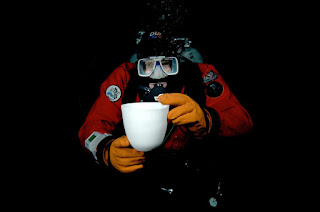
 Claire and I find flat, easy-to-drill ice (finally!)
Claire and I find flat, easy-to-drill ice (finally!)Monday, December 22, 2008
For the birds
It's a good thing my "polar wings" were spread when I landed here. Between the big ice storm last week (no power for 6 days), the recent snow, and now the bitter cold, it's as though Explorers Cove doesn't want to release her grip.
Some musings today about birds and making images, just to warm the spine:

Finches at the bird feeder during a snowstorm

Chickadee tracks in the snow
Frozen footprints and fossil tracks represent hard evidence of reality in the natural world. I find it interesting that photographs were once analogous to these tracks. That's no longer true, thanks to digital imaging and software that allow us to merge images seamlessly. For example, I can show you compelling pictures of Chairman Mao wearing a New Jersey Devils uniform (I hear he was a big ice hockey fan!) or Caroline Kennedy pushing a broom at Wal-Mart (that's what every soccer-mom representative of middle-class America has done, right?). But do such images represent reality? No - they are manifestations of the imagination. What has unlocked our limitless creativity has also shattered our faith in photographic evidence. It's a New Age for creatives ... as well as charlatans and thieves.
There is considerable debate among scientists about how we should use images to report our findings, i.e., to depict the realities of nature. I have touched on this topic in my art/science blog, and it is something that Claire Beynon and I have incorporated in previous work.
Tuesday, December 16, 2008
Out of the frying pan ...
...and into the fire. In my case, however, the expression is "out of the freezer and onto the ice."
I left Explorers Cove because it became an icy, slushy mess. Look at the scene here in upstate New York!
Everything is coated with ice due to a freak storm. For the past four days, we've been without electricity ... and heat, and a washing machine, and a TV. It's like camping near the Herbertson Glacier!
Well, not exactly...
Wednesday, December 10, 2008
Sweet sorrow
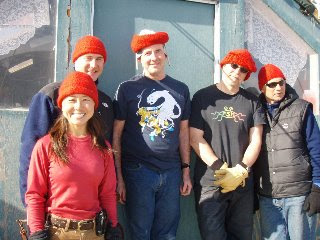


Tuesday, December 9, 2008
What we do to amuse


Sunday, December 7, 2008
Split rocks and long shadows


Sunday, November 30, 2008
Water water everywhere and lots of drops to drink


Thursday, November 27, 2008
A view of above

There are temperate places on Earth where, looking through the forest canopy toward the night sky, one would find in the shadows vines clinging to crenated bark, moss hanging limp from branches, and hints of the heavens piercing heavy, moist air. Tonight, however, an upward glance from our sleeping bags reveals green arches, Jamesway blankets flapping in the wind, and an upside-down wardrobe of layers. Moments ago we were onions of polypropylene leggings and undershirts, silk socks, wool socks, Thinsulate glove liners and Gore-Tex glove shells, wind pants, briefs (not boxers), knickers, hats, gaiters, goggles, a Big Red parka, and bunny boots. Unwashed and unkempt, the outerwear is sprayed with the ocean, their fringes crusted in white. The innerwear is likewise moist, although sweat - being more organic than seawater - thankfully fails to encrust. We inhale dry desert air laden with Taylor Valley dust, and exhale the taste of instant decaf mixed with cocoa. Geologists, biologists, artists, and divers - eight souls on board a tiny camp at the edge of the world.
Tuesday, November 25, 2008
Mucking a dive hole
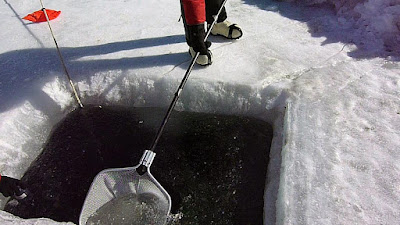


Sunday, November 23, 2008
Bay of Wails
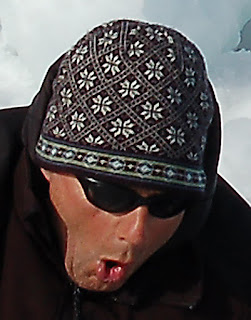
How cold is -2C (28F) water? Ask Steve Clabuesch. He was tending the first dive at the Bay of Sails. While preparing to deploy the down line, he got a little too close to the edge of the hole, and "whoooops!" In the drink he went. "Yeeeouch!"


Thursday, November 20, 2008
Dirty Ice


Sunday, November 16, 2008
A bit unstuck
The Herbertson Glacier site is finally finished! The Hotsy melted a nice hole, and in the process the stuck drill bits dropped to the seafloor. Today we loaded our dive gear on the ATV and snowmobiles, and set out to collect specimens, map the undersea topology, catalog organisms living under the ice, deploy sediment traps and experimental arrays, and add a new layer to our art/science project. Oh, and to recover those pesky drill bits.
Thursday, November 13, 2008
Wet ones

I've had the privilege of working with some awesome scientific divers over the years, and I'd like to introduce a few of them here. The first is Dr. Joan Bernhard. I met "Joanie" during my first season in Antarctica, and we've remained close friends ever since. She is, in a sense, the sister I never had. (I haven't had the courage to pull her pigtails, though!) We collaborate on various projects, and often bounce ideas back and forth that ultimately lead to new adventures. We also spend a lot of time arguing about how to write our science papers. In fact, I owe Joan comments on a manuscript right now, so I better quickly introduce two other divers and get right back to work on it.


Monday, November 10, 2008
A bit stuck

I've been away from blogging for a few days, and here's the culprit: a stuck drill bit, as shown underfoot by Steve Clabuesch. Unexpected problems like this are expected to happen in Antarctica.
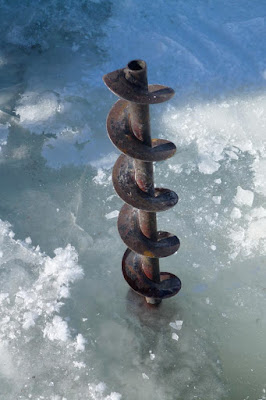
Tuesday, November 4, 2008
Three of a kind

Introducing the other two people who put G-093 together: Sally Walker (above, sporting her first dribble from the New Harbor coffee pot) and Molly Miller. Sally is posting updates on her Antarctic experiences as "Postcards from the Poles" at the Windows to the Universe site. Molly's website has links to her Antarctic experiences, too.

Monday, November 3, 2008
Coring never boring


Friday, October 31, 2008
New Harbor Flag Day

Camp does not feel settled until we fly flags on the roof. Since 1990, flags designed by school children have accompanied the camp's American flag. Boy Scouts visiting the camp have also flown their troop flags. I flew the New York State flag for about a decade (it eventually deteriorated), and once even flew the flag of Texas in honor of an exceptional man.

Wednesday, October 29, 2008
Art/Science on Ice
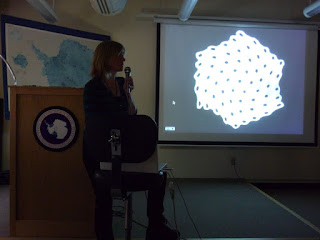


Last night, Claire and I presented a talk about our art/science collaboration to the McMurdo Station community. It was the third time we've spoken together and, to be honest, the first time I've felt completely at ease.



